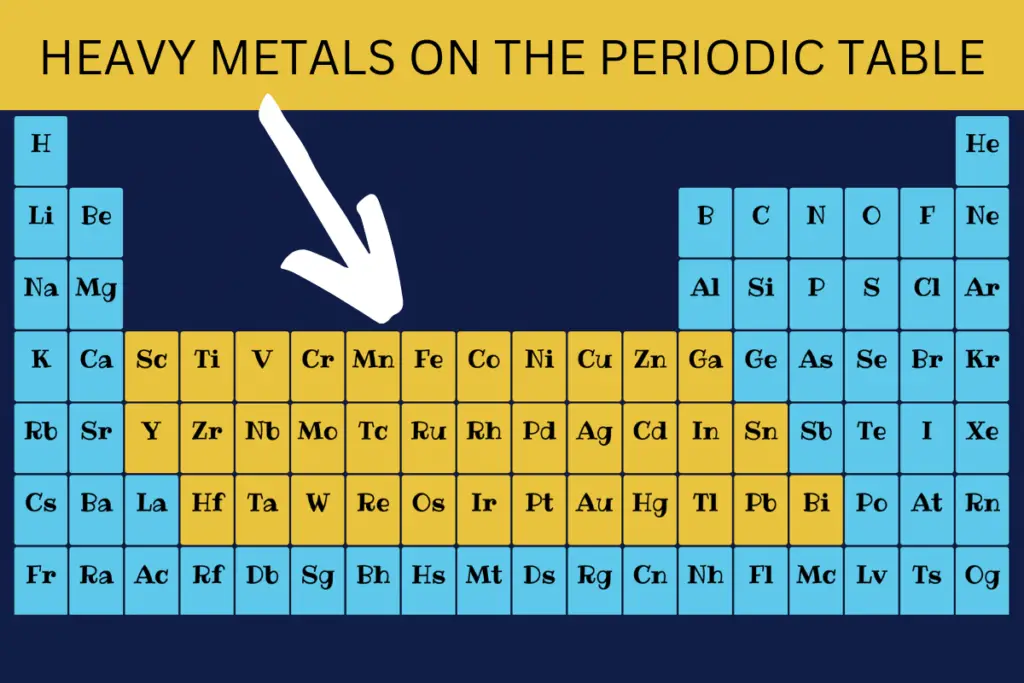As of today, we know about 40 heavy metals. However, five of them, (arsenic, cadmium, chromium, lead, and mercury) are of primary concern due to their high toxicity. They are common air pollutants and can cause various adverse health effects upon exposure and should be removed from the air, ideally with an air purifier.
Air purifiers with HEPA filters, ionizers, or electrostatic filters can remove particulate heavy metals (arsenic, cadmium, chromium, lead, etc.) from the air, while the purifiers with activated charcoal, TiO2 filters, or ozone generators can significantly reduce airborne mercury vapors.
This article explains the heavy metals that are of greatest concern, how different components of air purifiers remove them, and how effective they really are.
If you want to jump to the best three air purifiers for heavy metal removal, click here.
Heavy Metals of Concern
Heavy metals are often considered to be all the identified elements that have a density five times higher than water (Check out where heavy metals fall on the periodic table below).

While several heavy metals occur in the environment, let’s take you through the five important heavy metals when it comes to airborne contaminants in your home.
1. Mercury
Mercury (Hg) is a chemical element normally found in rocks and coal deposits. It has applications in the manufacturing of chemicals and electrical and electronic appliances.
It exists as a liquid at room temperature, which is partly why it has been used in thermometers for generations. However, it easily evaporates and becomes a colorless, odorless vapor (gas).
Sources In Air
Common sources of mercury in the air are fire breakouts, soil, exhaust fumes from burning fossil fuels, volcanoes, weathering of rocks, and medical and municipal waste.
Health Effects
According to the Centers For Disease Control (CDC), the health effects of mercury exposure are:
- Eye and skin irritation
- Cough
- Chest pain
- Shortness of breath
- Insomnia
- Irritability
- Headache
- Weight loss
According to the National Institute for Occupational Safety & Health (NIOSH), airborne mercury exposure of 0.05 mg/m3 over 10 hours is safe. Beyond this level, people may start experiencing hazardous and potentially fatal health symptoms.
2. Arsenic
Arsenic (As) naturally exists in the Earth’s crust and is found across all ecosystems (air, water, and soil).
Sources In Air
Arsenic is generally produced from high-temperature processes such as power plants, fires, and volcanic activity. It occurs in the air as a mixture of arsenite and arsenate and is usually attached to other airborne particles.
Health Effects
Side effects of exposure to airborne arsenic are:
- Burning sensation in nose, mouth, and eyes
- Coughing
- Shortness of breath
- Headache
- Sore throat
- Dizziness
According to the CDC, exposure to only ten micrograms of arsenic per cubic meter of air is permissible.
3. Cadmium
Cadmium (or Cd) is a bluish-white metal mainly found in zinc ores. Other than that, soil, tobacco, rice, cereal grains, and potatoes also contain cadmium.
Sources In Air
Smelters are the most common sources of airborne cadmium. Others include burning fossil fuels, tobacco smoke, plastics, and nickel-cadmium batteries.
Health Effects
Airborne cadmium can cause:
- Flu-like symptoms (chill, fever, muscle pain)
- Lung damage and disease
- Impairment of kidney functions
- Bone diseases
Forty micrograms of Cd per cubic meter of air is considered safe.
4. Chromium
Chromium (or Cr) is a mineral that is used to treat diabetes, high cholesterol, and bipolar disorder and to improve athletic performances.
Sources In Air
The chemical manufacturing industry and the burning of fuels (coal, oil, and natural gas) are primary sources of airborne chromium.
Health Effects
While chromium is used for medicinal purposes, long-term exposure to hexavalent chromium or Cr(VI) can have adverse health effects such as:
- Irritation in the nose, throat, and lungs
- Ulcers
- Perforation of the nasal septum
According to OSHA, airborne exposure to 1 mg/m3 of chromium for 8 hours is safe.
5. Lead
Lead (or Pb) is widely used in car batteries, paints, ammunition, weight belts, radiation protection, and cable sheathing. Naturally, it exists in the Earth’s crust, where it often combines with oxygen and sulfur.
Sources In Air
Metal processing and piston-engine aircraft are major contributors to airborne lead.
Health Effects
The health effects of airborne lead vary based on the length and level of exposure. Lead can:
- Damage nervous system
- Impair kidney function
- Reduce reproductive functions
- Restrict development
- Cause cardiovascular disorders
According to the CDC, exposure to 50 micrograms per cubic meter of airborne Pb for 8 hours is safe.
Of the above five heavy metals, only mercury occurs in a gaseous state in the air, whereas others are found as fine particles (dust).
Air Purifiers, Filters And Heavy Metals
Air purifiers are devices that remove airborne pollutants. They draw the room’s air inside and pass it through a series of filters, each of which traps a different type of contaminant. Finally, clean air is then emitted into the room.
Whether or not an air purifier removes a certain type of pollutant depends on the filters installed.
Here are the main types of air filters:
Pre-Filter:
These are present in almost all modern air purifiers. Their large pores (100 to 3000 microns) are generally incapable of capturing fine particles; however, they do remove dust and debris from the air. They primarily serve to protect the other filters and components of the purifier.
- Pre-filters cannot remove heavy metals from the air.
True HEPA Filter:
“High-Efficiency Particulate Air’ Filters are currently one of the most advanced filtration systems with over 99% efficiency. Their microscopic pores can trap all kinds of particulate matter measuring 0.3 microns or more. This includes pollen, dust, smoke particles, dander, hair, and germs like mold, bacteria, and viruses.
- While the particle size of heavy metal dust varies, they usually fall in the size of HEPA filters, and therefore, HEPA air purifiers can efficiently remove most heavy metals from the air.
Activated Charcoal Filter:
These are made by heating and oxidizing pure coal. The process turns the coal into a highly-porous material (activated charcoal) that adsorbs gases, volatile organic compounds (VOCs), and chemicals to its surface.
- These airborne pollutants are then captured into the filter pores, which prevents the gases from escaping the air purifier.
- Activated charcoal filters have shown promising results in the filtration of mercury vapors.
Ionizers:
Ionizers are devices that emit high-energy charged particles (negative ions). This creates static electricity in the environment, which causes particulate substances to settle down and stick to the ionizer and other surrounding surfaces.
- These are especially effective against fine particles like heavy metal dust.
Electrostatic Filters:
These are the same as ionizers, except that they emit both positive and negative ions.
- Heavy metal particles, smoke particles, dust, pollen, dander, etc., are all extracted from the air in the electrostatic chambers.
TiO2 Filter:
TiO2 or titanium dioxide filters employ photocatalysis for air filtration. This implies that in the presence of light (mostly UV radiation), TiO2 activates and forms free oxygen radicals. These radicals break down and destroy the chemical composition of organic compounds, gases, and VOCs.
- TiO2 has been tested for mercury removal. They are frequently used in aquatic solutions to treat the wastewater and filter mercury from it. This suggests that they can remove mercury vapors in air purifiers as well.
Ozone Generators:
Ozone generators are substances that use UV radiations or electrical discharge to break down oxygen molecules in the air. This generates singular oxygen atoms that readily react with oxygen molecules to form ozone.
This is a high-reactive, unstable gas that immediately donates its third (nascent) oxygen atom to environmental reagents (gases, VOCs, and chemicals). As a result, the chemical makeup of the airborne contaminants are altered, which reduces or nullifies its toxicity.
- On its own, ozone does reduce mercury in the environment. However, an interesting phenomenon is observed when activated carbon filters are exposed to ozone. The ozone treatment increases the mercury capture capacity of carbon by a dramatic factor of 134.
- Bear in mind that this effect of ozone on carbon is destroyed by atmospheric exposure, heating, and water vapors.
Air Purifiers And Heavy Metal Filtration
After a detailed discussion on air filters, we can say that HEPA filters, activated charcoal filters, ionizers, electrostatic filters, TiO2 filters, and ozone generators are all effective against airborne heavy metals.
However, along with air filtration, we also need to take safety into account. While most of these filters are safe, ozone generators and ozone-producing filters like ionizers and electrostatic filters.
The high-energy particles emitted from ionizers and electrostatic chambers break oxygen molecules down, which eventually causes ozone production. It is essential to mention that ozone created due to ionization is often minimal and does not pose significant health risks.
Ozone naturally exists in the environment as an atmospheric sheath that protects the Earth from harmful ultraviolet radiation. However, when produced artificially, it has a range of adverse side effects, such as:
- Chest pain
- Headache
- Shortness of breath
- Eye, nose, and throat irritation
- Lung damage
- Cardiovascular disorder
- Ischemia (loss of blood supply to the heart)
- Asthma and emphysema attack
- Skin inflammation
They can also restrict plant growth and cause irreversible damage to animal health.
According to NIOSH, just 0.1 ppm of ozone is safe, whereas five ppm or higher levels of the gas are dangerous and can immediately lead to death. While ozone produced during air or water treatment is strictly regulated, it can still lead to health complications. This is why it is better to avoid ozone generators while other effective alternatives are available.
Best Air Purifiers For Heavy Metals
The best air purifiers for heavy metals contain a HEPA filter as well as either an activated carbon or TiO2 filter – this ensures both heavy metal particles and mercury vapors are removed from the air.
Here are three of the best air purifiers for heavy metal removal:
LEVOIT H13 HEPA Air Purifier
LEVOIT is a popular company that takes pride in manufacturing safe, non-ozone-producing appliances. Their H13 HEPA Air Purifier offers premium air filtration with over 99% efficiency. It effectively traps particulate substances from air, including heavy metals, dust, dander, and pathogens, protecting you and your pets from various allergies and health conditions.
For enhanced filtration, the unit also comes with a UV-C bulb that emits 256 nm ultraviolet radiation. This inactivates and destroys microbial DNA and ensures the maximum elimination of airborne germs from your environment.
Modify MA-40 Air Purifier
The last product on our list is Medify MA-40 Air Purifier. This is a large room air purifier. It covers 840 sq. ft. in 30 minutes and 1600 sq. ft. in an hour, giving you a fresh, toxin-free environment within an hour of operation.
The unit comes with a medical grade 13 HEPA filter that removes 99.9% of harmful particles like heavy metals, dust, dander, pollen, dander, etc. Unlike most conventional HEPA filters, this one can capture particles measuring 0.1 microns or more.
The unit can be customized using several versatile controls like multiple fan speeds, timer, etc. It is virtually silent, allowing an easy and comfortable sleep.
Alen BreatheSmart 45i Air Purifier
The next product on the list is Alen BreatheSmart 45i Air Purifier. It is a mid to large-sized room air purifier that covers 800 sq. ft. area in an hour.
The unit comes with a series of filters. First is the medical grade 13 HEPA filter that captures 99.99% of tiny particles, measuring as small as 0.1 microns. In this step, almost all the major airborne contaminants (heavy metal dust, debris, germs, etc.) are removed.
Next to the HEPA filter lies a B4 filter that also captures particulate matter.
Other than that, this unit also has an activated charcoal filter that filters odor, mercury, chemicals, smoke, etc.



